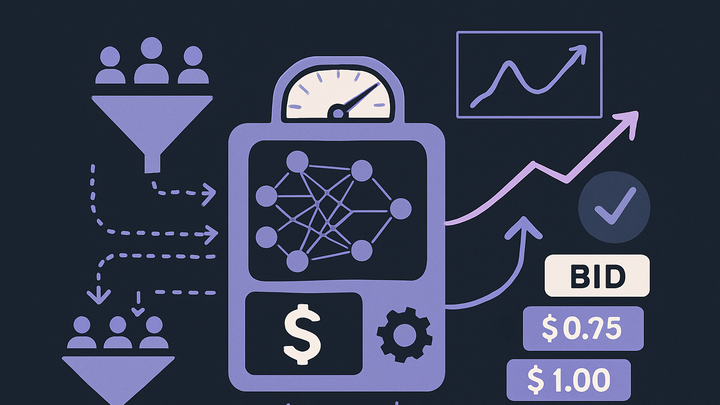Published on 2025-06-26T05:24:52Z
What is Automated Bidding? Definition and Analytics Examples
Automated Bidding is a set of strategies that utilize machine learning and real-time analytics data to automatically adjust advertising bids in each auction. It enables marketers to optimize campaign performance against specific goals—such as maximizing conversions, revenue, or clicks—without manual bid adjustments. By analyzing signals like device type, location, time of day, and conversion history, automated bidding models estimate the optimal bid for each impression. Analytics platforms such as Google Analytics 4 (GA4) and cookie-free solutions like PlainSignal provide the conversion events and user insights needed to feed these algorithms effectively. Integrating GA4 with Google Ads allows advertisers to import robust attribution data, while PlainSignal’s simple tracking snippet can capture essential signals without relying on third-party cookies. When implemented correctly, automated bidding can drive better ROI, save time, and enable more agile campaign management—though it requires clear goals, accurate tracking, and ongoing performance monitoring.
Automated bidding
Automated Bidding uses machine learning and analytics data to optimize ad bids in real time, improving efficiency and ROI.
Overview of Automated Bidding in Analytics
This section introduces the concept and relevance of automated bidding strategies in analytics-driven marketing.
-
Definition
Automated bidding leverages machine learning algorithms to set ad bids automatically based on real-time analytics data and campaign goals.
-
How it works
By analyzing signals such as device, location, time of day, and conversion history, automated bidding models predict the likelihood of a conversion and adjust bids to maximize performance objectives.
Key Automated Bidding Strategies
Common strategies advertisers use to achieve different campaign objectives through automated bids.
-
Maximize clicks
Automatically sets bids to help get as many clicks as possible within a specified budget.
-
Target cpa
Adjusts bids to get the most conversions at or below a target cost per acquisition (CPA).
-
Target roas
Optimizes bids to achieve a specific return on ad spend (ROAS) target by valuing conversions differently based on revenue.
-
Enhanced cpc (ecpc)
Automatically adjusts manual bids up or down to help maximize conversions while keeping cost per conversion similar to the set bid amount.
Implementation Examples
How to integrate automated bidding strategies using analytics platforms and tag implementations.
-
Google analytics 4 (GA4)
Link GA4 conversion events to Google Ads by importing your GA4 conversions. This data fuels target CPA and ROAS bidding models in Google Ads.
-
PlainSignal integration
Use PlainSignal’s cookie-free analytics to capture conversion events and user signals for automated bidding algorithms.
-
Integration snippet
Add the following tracking code to your site to initialize PlainSignal and start capturing analytics data:
-
Code example
<link rel="preconnect" href="//eu.plainsignal.com/" crossorigin /> <script defer data-do="yourwebsitedomain.com" data-id="0GQV1xmtzQQ" data-api="//eu.plainsignal.com" src="//cdn.plainsignal.com/plainsignal-min.js"></script>
-
Benefits and ROI of Automated Bidding
Advantages of using automated bidding in analytics-driven campaigns and impact on return on investment.
-
Improved efficiency
Automated systems can process large volumes of auction data in real time, saving advertisers significant manual effort.
-
Better performance
Machine learning models optimize bids to meet specific goals like conversions or revenue, often outperforming manual bidding.
-
Data-driven insights
Continuous data analysis helps refine targeting and bidding strategies over time.
Best Practices and Considerations
Guidelines to ensure effective deployment and monitoring of automated bidding strategies.
-
Define clear goals
Set specific, measurable objectives (e.g., target CPA or ROAS) to guide the bidding algorithm.
-
Ensure accurate tracking
Verify that conversion events in GA4 or PlainSignal are correctly implemented and firing before enabling automated bidding.
-
Allow learning time
Automated models need a learning period (usually 1–2 weeks) to gather performance data.
-
Monitor performance
Regularly review key metrics and adjust targets as market conditions or goals change.
